Building Community Bonds through Birding
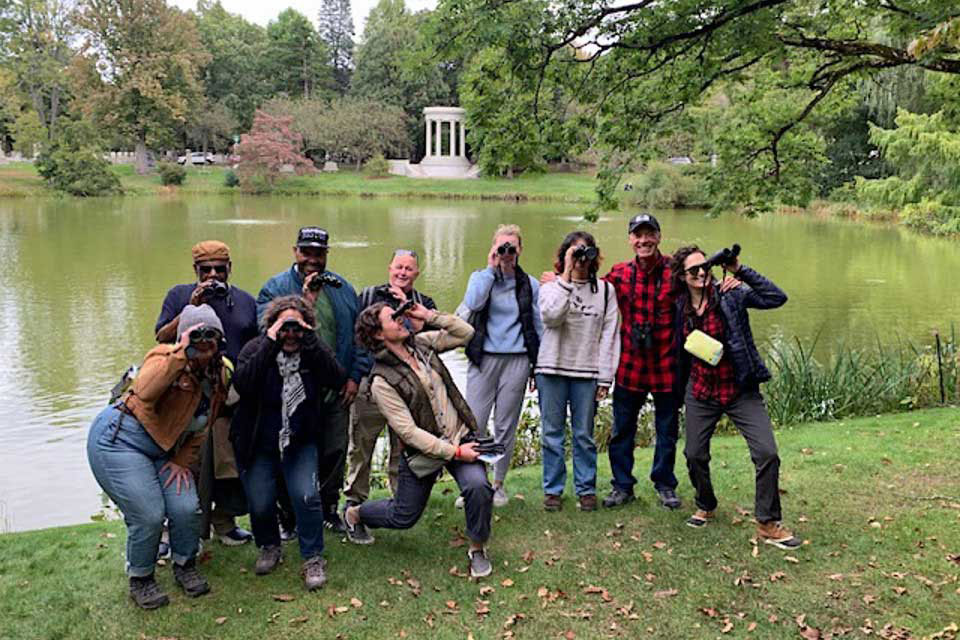
Members of the PEP community spend an afternoon birding at Mt. Auburn Cemetery. Photo by Jessi Brewer.
Members of the Partakers Empowerment Program (PEP) community gather at Mt. Auburn Cemetery for a bird walk with the Mass Audubon Boston Nature Center.
By Jessi Brewer
“Hope” is the thing with feathers
That perches in the soul
And sings the tune without the words
And never stops, at all
–Emily Dickinson
On a crisp and chilly October afternoon, members of the Brandeis Educational Justice Initiative (BEJI) gather at Mt. Auburn Cemetery to look for birds. Though the vibrant oranges and yellows might signify decay and the coming of another winter for some, there is so much hope for the future present here. Fall in New England marks a time of change. It means migration. A time of moving and transition. And for many of the people here today, what better metaphor for this season of their lives than just this: change.
Meeting here in the cemetery are members of the Partakers Empowerment Program (PEP), a fourteen-week workshop series that aims to ease the challenges of reentry for returning citizens. This bird walk brings together people from all walks of life: students and faculty from Brandeis University, mentors from Partakers–a community organization that works to reduce recidivism through educational opportunities and mentorship, and several formerly incarcerated persons who collectively have served over 150 years in prison.
But this walk is not about prison. It’s not about how the United States incarcerates more people than almost anywhere else in the world and that there are currently 1.9 million people locked away in 2023. It’s not about how this number has increased exponentially in the last 40 years, or how in Massachusetts alone there are 16,000 residents currently locked up and over 55,000 under surveillance. And for many of the returning citizens enrolled in the PEP program, the stigma and struggle of reentry marks the beginning of a long and uphill battle against recidivism. For some present today, this is not just their first birding adventure, this is their first Fall on the outside. But, this walk is not about prison. This walk is about the birds.
We are greeted upon our arrival by the belting of a song sparrow on the cemetery lawn. Through the binoculars we can see its small head thrown back and hear the melodic chirping fade into a light trill. We pause, adjust and focus our binoculars, and spend a few moments describing for one another where we can see the little brown bird: “look beyond the fountain, in the bushy group of trees, to the left–no, further left, at the tip of the branches.” Almost everyone gets to see the little sparrow sing. This will be one of many birds we see together today.
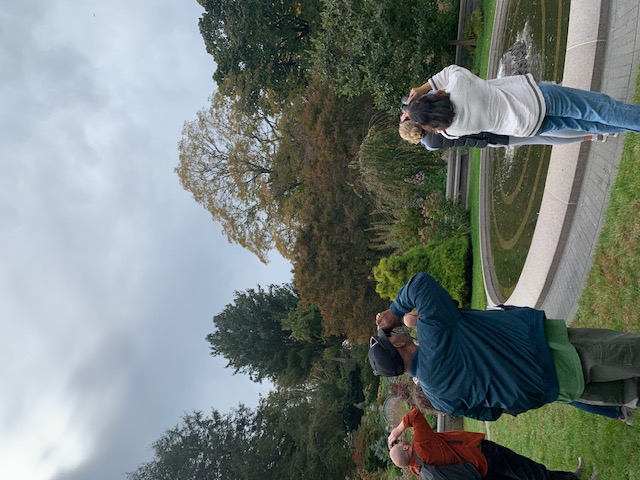 Members of the PEP community view birds with binoculars provided by Mass Audubon. All photos by Jessi Brewer.
Members of the PEP community view birds with binoculars provided by Mass Audubon. All photos by Jessi Brewer.
“What are those two birds flying around? With the white under wings?” Robert asks. He’s noticing a pair of mockingbirds dipping and diving in the trees nearby. Robert participated in the 2022 PEP cohort and then returned to serve as a teaching assistant the following semester. Just recently, he got his own apartment and has been adjusting to life on his own. Robert is an outdoor guy. We learn on this birding walk that he once hiked the Appalachian trail at the age of sixteen. “2000 miles,” he tells us, where he encountered “barefoot squirrel hunters from Virginia” that made him a little nervous (this was pre Deliverance though, he notes with a chuckle). His hike was cut short by weather and a worried mother. But even on this hike, it’s clear that Robert enjoys being in nature. He has wandered on his own a lot during this walk, climbing off trails and wandering up steep hills–one which we thought would surely end in a fall, but thankfully, did not. Birding marks a change for Robert. Being able to wander. To adventure. On the outside, he walks ten miles a day regularly and rides a bike everywhere.
James, a grandfather to twelve, tells us of the birth of his youngest granddaughter, Dream. “I spend time with all of my grandchildren,” he says, beaming. James’ tenderness towards children has been visible today in his absolute delight in saying hi to each family with young children in the cemetery. He even took a moment to distract, and temporarily calm, a crying baby we mistook for a catbird in the distance. This is his first time birding, though he watches birds in his backyard. He takes a phone call during the walk from one of his adult children. we hear him tell her, “Yes, I am birding! At Mt. Auburn, watching the birds with everyone.”
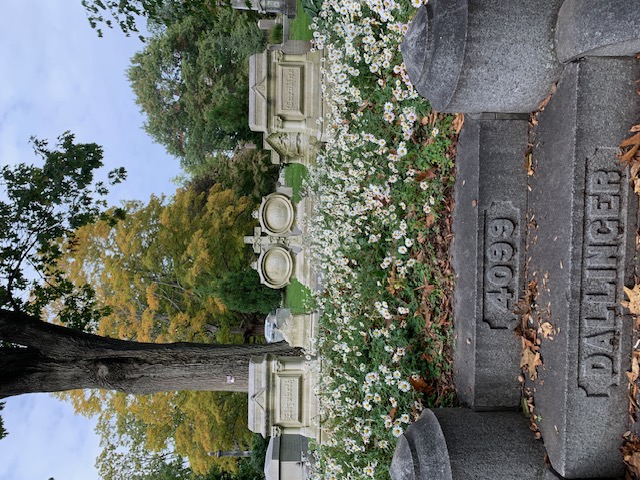 This image is of some of the gravestones at Mt. Auburn Cemetery.
This image is of some of the gravestones at Mt. Auburn Cemetery.
This walk is guided by the Mass Audubon Boston Nature Center, who has lent extra binoculars and a wonderful guide–Sal. We pause and listen to the various calls of the blue jays and mockingbirds, spot a few song sparrows along the way, and notice a few cardinals. We can hear more birds than we see, but there is so much more to look at here. The trees are in their full fall glory and the gravestones are unique and spark many conversations about burials, legacy, and even hauntings. But more importantly, they spark conversations about life.
Dawud, a PEP graduate and current teaching assistant, points out a few places good for meditation. His faith is a visible and vital part of him. Today, he wears a pin on his shirt that says “The Solution: Ahmadiyya Islam ‘Love for All, Hatred for None.” He also has a vivid imagination, hinting at the many spirits and ghosts that might wander here in the night, long after the gates have closed. There are other, though very unexpected, sources of joy and identification here: trees. David, another former PEP participant and teaching assistant, spends most of the afternoon delightfully sharing the identification of trees.
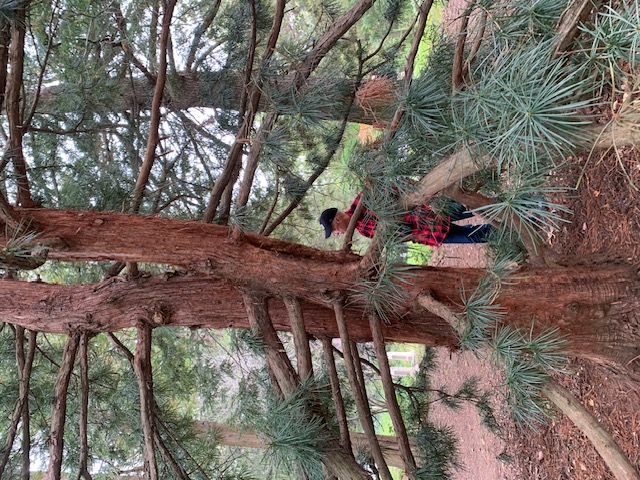 David Williams, a former teaching assistant for PEP, identifying trees in the cemetery.
David Williams, a former teaching assistant for PEP, identifying trees in the cemetery.
He does not just identify them, he touches them, he beckons us to touch them, to stand under them and look up, to hear where they are from, and to absolutely marvel at not only their beauty, but their ability to exist and thrive in a place that is not their home. “I’m sad to see the summer go,” he says as we look out over a pond. I ask him why when there is such beauty in the fall. “I got out in the fall. This was my first summer on the outside.” He is referring to his time spent in prison and how for the first time in over thirty-nine years, he has been able to enjoy the sun without restriction.
The day culminates in a hawk sighting. A large red-tailed hawk swoops above us a few times and lands ina nearby tree. He hides amidst the branches and becomes difficult for most of us to see. James and David spend several minutes directing Sara and Cassie, both mentors for the Partakers program for several years now, on where to focus their binoculars. After a few minutes, we are all pointing, laughing, and desperately searching for this camouflage bird of prey in the distance. And finally, with the help of the group, everyone gets the bird in their view. This is what the day has been about: communing with birds, but also communing with each other.
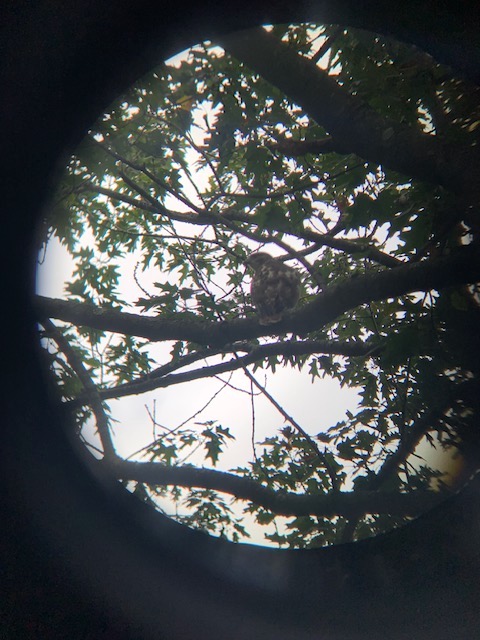 A red-tailed hawk sits perched in a tree.
A red-tailed hawk sits perched in a tree.
Rosalind Kabrhel, chair of the legal studies at Brandeis University and co-found of BEJI, reflects on the day: “it’s so important to have these opportunities to gather and just be in the same place talking about something neutral, a shared interest, or even better, learning something new.” Two Brandeis undergraduate students, Adah Anderson and Nemma Kalra, share this sentiment about their experience birding with the group: “I think nature is already such a dynamic environment and immediately gives people a lot to talk about…we were talking and laughing the whole time,” says Nemma. Adah also mentions the laughter: “I just really enjoyed being able to laugh and talk with everyone.”
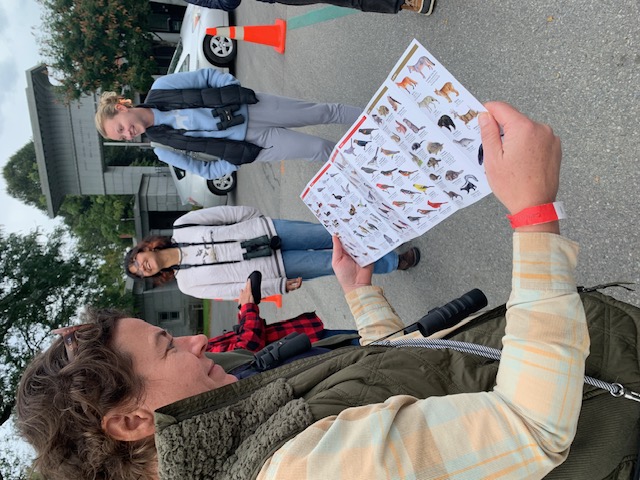 Brandeis faculty member Rosalind Kabrhel and Brandeis undergraduates Nemma Kalra and Adah Anderson preparing to look for birds,
Brandeis faculty member Rosalind Kabrhel and Brandeis undergraduates Nemma Kalra and Adah Anderson preparing to look for birds,
Statistics claim that 33% of people leaving prison will return within three years in Massachusetts. The community we are building here at PEP works against this statistic. We strive to go beyond providing resources, but to get to know one another, to build a network of support, mentorship, and friendship that encourages those returning home to have a positive impact on their communities–and so many of them are already having a positive impact on us. The participants present here today have told their stories in front of lawmakers, students, community leaders, and other returning citizens; they have served as leaders and facilitators in recovery programs, reentry services, and educational programs; they have worked with community organizations such as Justice for Housing, PEP, Partakers, and many more. Some have received degrees, and others plan to. Their collective impact is emblematic of the broader potential and enduring hope that underlies our approach to reentry.
On our way out of the cemetery gates, we see a few turkeys. One is attempting to fight his reflection in a car door, others are grazing lazily in the lawn. We move outside the gates to gather around for hot cocoa, cider donuts, and to discuss our bird list. October marks the peak of fall migration here. The birds are adjusting their bodies and flight patterns in preparation for limited food sources and changing nesting habitats. They are preparing for a long and arduous flight. Some will travel short distances, and some, very long. But they will return in the spring more vibrant and colorful than ever.